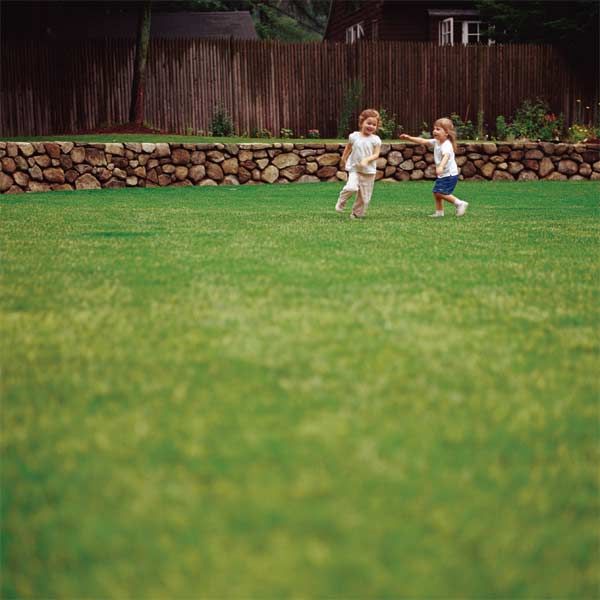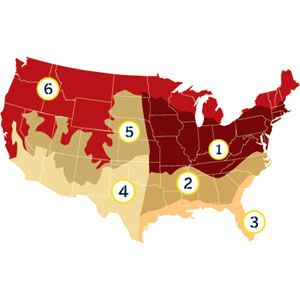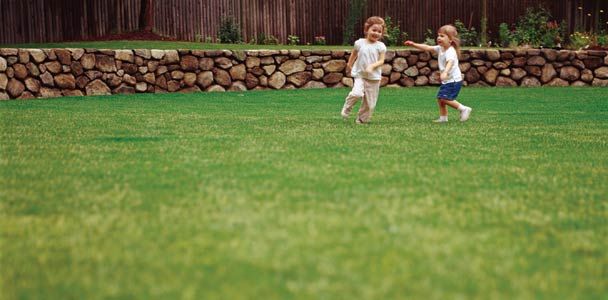
A lush, healthy lawn is the pride of many homeowners, but achieving and maintaining that perfect green carpet requires careful planning and consistent care. The key to success lies in following a well-structured lawn care schedule tailored to your specific region. This guide provides the essential tasks for keeping your lawn in top shape throughout the year, whether you live in the North or South of the United States.
Lawn Treatment Schedule
Understanding the unique needs of your lawn based on your geographical location helps you provide effective lawn care. The following schedules will aid you in maintaining a beautiful lawn year-round, regardless of where you live.
We’ve outlined the tasks season by season to make sure you give your lawn the care it needs in a timely manner.

North: Zones 1, 5, and 6
For those living in the cooler northern regions, including parts of New England, the Upper Midwest, and the Pacific Northwest, the following schedule will help you nurture a healthy lawn adapted to your climate.
March
As winter recedes, it’s time to prepare your lawn for the growing season by doing the following:
- Inspect your lawn for any winter damage or bare spots.
- Rake up debris and leaves from winter.
- Test your soil pH and nutrient levels to plan for fertilization.
April
Spring is in full swing, and your lawn care efforts should ramp up. Perform the following tasks:
- Apply the first dose of fertilizer, choosing a product suitable for your soil test results.
- Begin regular watering if rainfall is insufficient.
- The growing season starts, so you should mow the grass 3 inches high. Leave clippings on the lawn to return nutrients to the soil.
- Treat for crabgrass with preemergent herbicide or eco-friendly corn gluten.
May
As temperatures warm, weeds become more active, and here’s what you should do:
- Continue regular mowing, adjusting the height as needed based on grass growth.
- Fertilize six to eight weeks after the first dose in April, using a slow-release fertilizer for steady nutrition.
- Pull or spot-treat dandelions or treat the whole lawn with post-emergent weed control or lime.
June to July
Summer heat can stress your lawn, so focus on maintenance. Make sure you do the following:
- Monitor for signs of fungal diseases and treat them quickly if detected.
- Treat for grubs using beneficial nematodes or other eco-friendly methods.
- Water if rainfall is below 1 inch a week. Water deeply and less often to encourage deep root growth.
Late August to September
Fall is a crucial time for lawn rejuvenation, so it’s important that you:
- Dethatch and aerate with a core aerator when rain resumes, and the ground softens.
- Fertilize and seed bare or thin areas. Fall is the best time for overseeding cool-season grasses.
- Spread weed-and-feed over the entire lawn or spot-spray with lime juice and vinegar for organic weed control.
October to November
Prepare your lawn for winter dormancy by performing the following tasks:
- At the final cut, after a few frosts, mow 2 inches high to protect grass crowns during winter.
- Fertilize six to eight weeks after the last feeding with a winterizer formula high in potassium.
- Rake leaves regularly to prevent smothering the grass.
South: Zones 2, 3, and 4
For southern lawns, including those in the Southeast, Southwest, and parts of California, this schedule will help you maintain a vibrant lawn despite hot summers and mild winters.
March
Spring arrives earlier in the South, so start your lawn care routine promptly and do the following:
- Apply the first dose of fertilizer, choosing a product suitable for your grass type and soil conditions.
- Begin regular irrigation if rainfall is insufficient.
- The growing season starts, so make sure you mow 3 inches high (1–2 inches for Bermuda grass). Leave clippings on the lawn for natural fertilization.
- Treat for crabgrass with preemergent herbicide or corn gluten.
April
Take advantage of ideal growing conditions by doing the following:
- Dethatch and aerate to improve soil structure and reduce compaction.
- Monitor for emerging weeds and treat them as necessary.
- Plant seed in bare or thin areas. Choose grass varieties well-suited to your specific climate.
May
As temperatures rise, focus on maintaining consistent moisture and nutrition by keeping these tips in mind:
- Continue regular mowing, adjusting frequency based on grass growth rate.
- Fertilize six to eight weeks after the first dose using a slow-release formula for steady nutrition.
- Water if rainfall is below 1 inch a week. Water deeply in the early morning to minimize evaporation.
June to July
Summer heat can be intense, so prioritize lawn health by doing the following:
- Fertilize six to eight weeks after the second dose using a heat-tolerant formula.
- Raise mowing height slightly to protect grass roots from heat stress.
- Treat for fungus, if necessary. Look for signs of brown patch or dollar spot.
Late August to September
Prepare for the transition to fall with these tasks:
- Begin overseeding cool-season grasses if desired for winter color.
- Mow and water until the grass turns brown, indicating the start of dormancy for warm-season grasses.
- When grass greens up again, apply a final dose of fertilizer to support root growth.
October to November
Wind down your lawn care routine as growth slows by doing the following:
- Apply a final winterizer fertilizer to support root health during dormancy.
- Continue mowing until the grass stops growing, gradually lowering the height.
- Rake leaves to prevent smothering the grass and encourage air circulation.
Pro Advice: Roger Cook, This Old House Landscape Contractor, says, “To find out how much water a sprinkler delivers in an hour, place empty coffee cans on the lawn and run the sprinkler for 15 minutes. Pour collected water into one can and measure its depth. Divide by the number of cans and multiply by 4 to get the inch-per-hour rate. Then you’ll know how long to water to make sure grass gets 1 inch a week, 1/2 to 1/3 inch at a time. “
Seasonal Lawn Care Tips
To complement your region-specific schedule, here are some general tips to keep in mind throughout the year:
- Spring: Focus on weed prevention, soil testing, and light fertilization to kick-start growth.
- Summer: Prioritize proper watering, pest control, and maintaining a proper mowing height to protect against heat stress.
- Fall: Emphasize overseeding, core aeration, and applying winterizer fertilizer to prepare for the cold months.
- Winter: Minimize foot traffic on dormant lawns and plan for the upcoming growing season.
Our Conclusion
A well-maintained lawn improves your home’s curb appeal and provides a pleasant outdoor space for relaxation and activities. By following this region-specific lawn care schedule and implementing the provided tips, you can achieve a lush, healthy lawn that’s the envy of the neighborhood. Remember that consistency is key, and adapting your care routine to your local climate and grass type will yield the best results.

